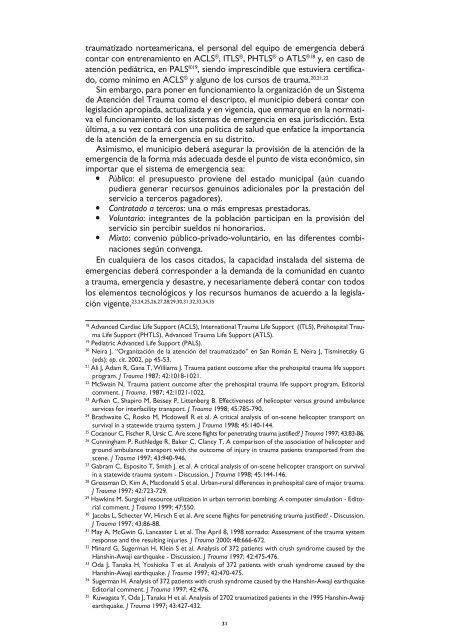Libro Academia Nacional de Medicina CONSENSO 2010-1
Libro Academia Nacional de Medicina CONSENSO 2010-1
Libro Academia Nacional de Medicina CONSENSO 2010-1
You also want an ePaper? Increase the reach of your titles
YUMPU automatically turns print PDFs into web optimized ePapers that Google loves.
traumatizado norteamericana, el personal <strong>de</strong>l equipo <strong>de</strong> emergencia <strong>de</strong>berácontar con entrenamiento en ACLS ® , ITLS ® , PHTLS ® o ATLS ®18 y, en caso <strong>de</strong>atención pediátrica, en PALS ®19 , siendo imprescindible que estuviera certificado,como mínimo en ACLS ® y alguno <strong>de</strong> los cursos <strong>de</strong> trauma. 20,21,22Sin embargo, para poner en funcionamiento la organización <strong>de</strong> un Sistema<strong>de</strong> Atención <strong>de</strong>l Trauma como el <strong>de</strong>scripto, el municipio <strong>de</strong>berá contar conlegislación apropiada, actualizada y en vigencia, que enmarque en la normativael funcionamiento <strong>de</strong> los sistemas <strong>de</strong> emergencia en esa jurisdicción. Estaúltima, a su vez contará con una política <strong>de</strong> salud que enfatice la importancia<strong>de</strong> la atención <strong>de</strong> la emergencia en su distrito.Asimismo, el municipio <strong>de</strong>berá asegurar la provisión <strong>de</strong> la atención <strong>de</strong> laemergencia <strong>de</strong> la forma más a<strong>de</strong>cuada <strong>de</strong>s<strong>de</strong> el punto <strong>de</strong> vista económico, sinimportar que el sistema <strong>de</strong> emergencia sea:• Público: el presupuesto proviene <strong>de</strong>l estado municipal (aún cuandopudiera generar recursos genuinos adicionales por la prestación <strong>de</strong>lservicio a terceros pagadores).• Contratado a terceros: una o más empresas prestadoras.• Voluntario: integrantes <strong>de</strong> la población participan en la provisión <strong>de</strong>lservicio sin percibir sueldos ni honorarios.• Mixto: convenio público-privado-voluntario, en las diferentes combinacionessegún convenga.En cualquiera <strong>de</strong> los casos citados, la capacidad instalada <strong>de</strong>l sistema <strong>de</strong>emergencias <strong>de</strong>berá correspon<strong>de</strong>r a la <strong>de</strong>manda <strong>de</strong> la comunidad en cuantoa trauma, emergencia y <strong>de</strong>sastre, y necesariamente <strong>de</strong>berá contar con todoslos elementos tecnológicos y los recursos humanos <strong>de</strong> acuerdo a la legislaciónvigente. 23,24,25,26,27,28,29,30,31,32,33,34,3518Advanced Cardiac Life Support (ACLS), International Trauma Life Support (ITLS), Prehospital TraumaLife Support (PHTLS), Advanced Trauma Life Support (ATLS).19Pediatric Advanced Life Support (PALS).20Neira J. “Organización <strong>de</strong> la atención <strong>de</strong>l traumatizado” en San Román E, Neira J, Tisminetzky G(eds): op. cit. 2002, pp 45-53.21Ali J, Adam R, Gana T, Williams J. Trauma patient outcome after the prehospital trauma life supportprogram. J Trauma 1987; 42:1018-1021.22McSwain N. Trauma patient outcome after the prehospital trauma life support program. Editorialcomment. J Trauma. 1987; 42:1021-1022.23Arfken C, Shapiro M, Bessey P, Littenberg B. Effectiveness of helicopter versus ground ambulanceservices for interfacility transport. J Trauma 1998; 45:785-790.24Brathwaite C, Rosko M, Mcdowell R et al. A critical analysis of on-scene helicopter transport onsurvival in a statewi<strong>de</strong> trauma system. J Trauma 1998; 45:140-144.25Cocanour C, Fischer R, Ursic C. Are scene flights for penetrating trauma justified? J Trauma 1997; 43:83-86.26Cunningham P, Ruthledge R, Baker C, Clancy T. A comparison of the association of helicopter andground ambulance transport with the outcome of injury in trauma patients transported from thescene. J Trauma 1997; 43:940-946.27Gabram C, Esposito T, Smith J. et al. A critical analysis of on-scene helicopter transport on survivalin a statewi<strong>de</strong> trauma system - Discussion. J Trauma 1998; 45:144-146.28Grossman D, Kim A, Macdonald S et al. Urban-rural differences in prehospital care of major trauma.J Trauma 1997; 42:723-729.29Hawkins M. Surgical resource utilization in urban terrorist bombing: A computer simulation - Editorialcomment. J Trauma 1999; 47:550.30Jacobs L, Schecter W, Hirsch E et al. Are scene flights for penetrating trauma justified? - Discussion.J Trauma 1997; 43:86-88.31May A, McGwin G, Lancaster L et al. The April 8, 1998 tornado: Assessment of the trauma systemresponse and the resulting injuries. J Trauma 2000; 48:666-672.32Minard G, Sugerman H, Klein S et al. Analysis of 372 patients with crush syndrome caused by theHanshin-Awaji earthquake - Discussion. J Trauma 1997; 42:475-476.33Oda J, Tanaka H, Yoshioka T et al. Analysis of 372 patients with crush syndrome caused by theHanshin-Awaji earthquake. J Trauma 1997; 42:470-475.34Sugerman H. Analysis of 372 patients with crush syndrome caused by the Hanshin-Awaji earthquakeEditorial comment. J Trauma 1997; 42:476.35Kuwagata Y, Oda J, Tanaka H et al. Analysis of 2702 traumatized patients in the 1995 Hanshin-Awajiearthquake. J Trauma 1997; 43:427-432.31


